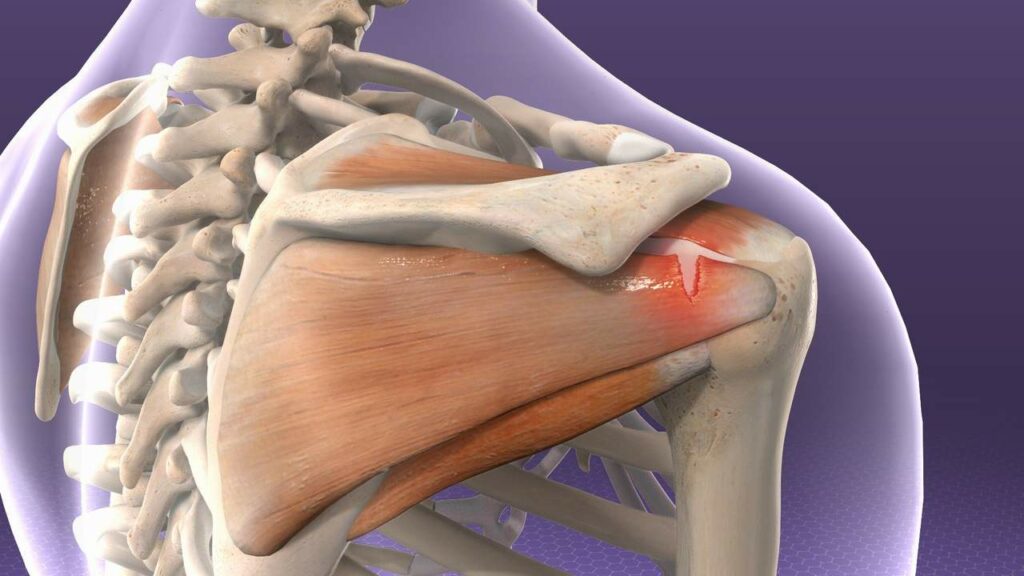For many, the joy of an overhead stretch or the simple pleasure of tossing a ball doesn’t come without a twinge of pain. This pain, often lurking in the shoulder, might be hinting at a condition known as rotator cuff tendinitis. As one of the most commonly affected areas in our body, the shoulder’s intricate design makes it both versatile and vulnerable. Dive into the world of rotator cuff tendinitis with us, from its origins to its solutions, ensuring that your shoulders can bear the weight of the world – pain-free.
Contents
What Is Rotator Cuff Tendinitis?
 Rotator cuff tendinitis, often referred to as shoulder tendinitis or impingement syndrome, is an inflammation of the tendons that comprise the rotator cuff in the shoulder. The rotator cuff is an ensemble of four muscles – the supraspinatus, infraspinatus, teres minor, and subscapularis – that converge into tendons to stabilize the head of the humerus (upper arm bone) within the shoulder socket.
Rotator cuff tendinitis, often referred to as shoulder tendinitis or impingement syndrome, is an inflammation of the tendons that comprise the rotator cuff in the shoulder. The rotator cuff is an ensemble of four muscles – the supraspinatus, infraspinatus, teres minor, and subscapularis – that converge into tendons to stabilize the head of the humerus (upper arm bone) within the shoulder socket.
This group plays a critical role in facilitating a variety of shoulder movements and ensuring joint stability. When these tendons become irritated or inflamed, it results in the condition known as rotator cuff tendinitis.
What Are The Causes Of Rotator Cuff?
The causes of rotator cuff problems, including tendinitis, tears, and other injuries, can be multifaceted and often arise from a combination of factors. Here are some of the primary causes:
- Repetitive Strain
Overhead activities are common culprits behind rotator cuff issues. For instance, athletes, especially baseball pitchers, tennis players, and swimmers, constantly engage in repetitive overhead motions. The continuous use and overstrain can cause microtears in the rotator cuff tendons, leading to inflammation and tendinitis.
- Age
Natural degenerative changes occur in our bodies as we age. The tendons and muscles lose their elasticity and strength over time. This aging process makes the rotator cuff more susceptible to injuries and tears. It’s the reason older adults often experience rotator cuff issues even without a traumatic event.
- Acute Injury
A sudden trauma, such as a fall on an outstretched arm or a forceful pulling motion, can cause the rotator cuff to tear instantly. This kind of injury is more common in younger individuals and can be quite painful, often requiring immediate medical attention.
- Bone Spurs
Bone spurs are bony projections that develop along bone edges. When they form on the underside of the acromion, they can rub against or “impinge” on the rotator cuff tendons. This friction can lead to inflammation and weaken the tendon over time, increasing the risk of tears. This is often referred to as “shoulder impingement syndrome.”
- Poor Posture
In today’s digital age, many people spend hours hunched over computers or phones. This forward-shoulder and rounded-back posture can narrow the space where the rotator cuff tendons reside. Over time, this can compress and aggravate the tendons, especially during arm elevation.
- Genetic Factors
There’s evidence to suggest that some individuals may be genetically predisposed to rotator cuff problems. If rotator cuff issues are common in a family, members might have an inherited trait making their tendons more susceptible to inflammation or tearing.
- Limited Blood Supply
Tendons, compared to other tissues, naturally have a limited blood supply. As we grow older, this blood supply can further diminish, making it challenging for the body to repair even minor tendon injuries. Over time, these small injuries can accumulate, increasing the risk of a significant tear or degenerative condition.
Recognizing and understanding these factors provides valuable insights into prevention strategies. Early detection and optimal management approach for rotator cuff ailments.
What Is The Best Treatment For Rotator Cuff Tendinitis?
 Treatment for rotator cuff tendinitis aims to alleviate pain, reduce inflammation, restore range of motion, and strengthen the shoulder muscles. Here’s a detailed look at common treatment approaches:
Treatment for rotator cuff tendinitis aims to alleviate pain, reduce inflammation, restore range of motion, and strengthen the shoulder muscles. Here’s a detailed look at common treatment approaches:
Conservative Management
Most cases of rotator cuff tendinitis respond well to non-surgical treatments.
- Rest and Activity Modification: It’s crucial to avoid activities that exacerbate pain or strain the shoulder. Taking a break from overhead movements or heavy lifting can allow the tendons to heal.
- Cold Compress: Applying ice to the affected shoulder can help reduce pain and inflammation. It’s recommended to ice the shoulder for 20 minutes several times a day during the acute phase.
- Nonsteroidal Anti-Inflammatory Drugs (NSAIDs): Over-the-counter medications like ibuprofen or naproxen can reduce pain and inflammation. Always consult with a healthcare provider before starting any medication.
Physical Therapy
Guided exercises and stretches are fundamental in treating rotator cuff tendinitis.
- Stretching: Gentle stretching exercises can help improve flexibility and range of motion in the shoulder.
- Strengthening: As pain diminishes, strengthening exercises target the rotator cuff and shoulder blade muscles. This fortifies the shoulder and prevents recurrent episodes.
Steroid Injections
If conservative measures don’t bring relief, corticosteroid injections can be administered into the shoulder joint. While they can significantly reduce inflammation and pain, repeated injections can weaken the tendon and are thus used judiciously.
Platelet-Rich Plasma (PRP) Therapy
An emerging treatment option, PRP involves drawing a patient’s blood, processing it to concentrate the platelets, and injecting it into the inflamed tendon. The growth factors in PRP can potentially expedite healing, but more research is needed to establish its efficacy.
Ultrasonic Treatment
A relatively new procedure, ultrasonic tenotomy, uses ultrasonic energy to remove damaged tissue. It’s minimally invasive and can be done as an outpatient procedure.
Surgical Intervention
Surgery is typically the last resort and is considered if:
- Symptoms have lasted for 6-12 months despite conservative treatment.
- The patient has a significant rotator cuff tear, or the tendon damage is severe.
There are different surgical approaches:
- Subacromial Decompression: Removes bone spurs or inflamed tissue that might be causing impingement.
- Rotator Cuff Repair: Fixes torn tendons.
Post-Treatment Rehabilitation
After any treatment, especially surgery, rehabilitation plays a vital role. A tailored physiotherapy program ensures the shoulder regains its strength and functionality.
Remember, while the above treatments are commonly recommended for rotator cuff tendinitis, it’s essential to consult with an orthopedic surgeon or a sports medicine specialist. They will help to determine the best treatment approach for an individual’s specific situation.
How Can I Strengthen My Rotator Cuff?

Strengthening the rotator cuff is crucial for shoulder stability and function. Here are exercises specifically designed to target and strengthen the rotator cuff muscles (supraspinatus, infraspinatus, teres minor, and subscapularis).
Internal Rotation
- Sit or stand with your elbow close to your side and bent at 90 degrees.
- Hold a resistance band or a cable pulley, with the other end anchored in front of you.
- Keep your elbow close to your side and pull the band or cable towards your stomach.
- Slowly return to the starting position.
- Perform 2-3 sets of 10-15 repetitions on each arm.
External Rotation
- Similar to the internal rotation but in the opposite direction.
- Anchor the band or cable at waist level on your side.
- Hold the band with your arm at a 90-degree angle and your elbow close to your body.
- Rotate your forearm outward, away from your body, then slowly return to the starting position.
- Perform 2-3 sets of 10-15 repetitions on each arm.
Scaption (Shoulder Elevation in the Scapular Plane)
- Stand holding light dumbbells by your sides.
- With your thumbs pointing up, lift your arms at a 30-degree angle to your body (in line with the plane of your shoulder blade).
- Raise your arms until they’re at shoulder level, then lower them slowly.
- Perform 2-3 sets of 10-15 repetitions.
Side-Lying External Rotation
- Lie on your side with the affected shoulder facing up.
- Hold a light dumbbell with your elbow bent at 90 degrees.
- Keeping your elbow close to your side, lift the dumbbell towards the ceiling by rotating your shoulder.
- Slowly lower it back down.
- Perform 2-3 sets of 10-15 repetitions on each arm.
Face Pulls
- Using a resistance band or cable pulley system at face level, grip the ends or handles.
- Pull the band or cables towards your forehead, splitting your hands apart and squeezing your shoulder blades together.
- Your hands should be wider than your shoulders at the peak of the motion.
- Slowly return to the starting position.
- Perform 2-3 sets of 10-15 repetitions.
Pendulum Exercise
- Lean forward slightly, allowing one arm to hang down and swing in a small circle.
- Rotate the arm in both directions.
- This exercise helps with mobility but also offers some strength benefits.
Wall Push-ups
- Stand facing a wall.
- Place your hands on the wall at shoulder height and perform a push-up motion.
- This exercise targets shoulder stability without placing too much strain on the rotator cuff.
For all exercises, it’s vital to maintain good form to prevent injury and to ensure the targeted muscles are being worked effectively. If you experience any pain beyond typical muscle soreness, stop the exercise and consult a healthcare professional.
Conclusion
In conclusion, rotator cuff tendinitis, while often overlooked, plays a pivotal role in our daily activities and overall shoulder health. Strengthening it not only aids in preventing injuries but also ensures optimal shoulder functionality. Like any fitness regimen, consistency is key, and it’s crucial to prioritize proper form over intensity to reap the benefits without the risks.
Taking proactive measures for our rotator cuff today can translate to a pain-free and mobile tomorrow. If you’re experiencing Shoulder pain, physical therapy for shoulder pain at PhysioMantra can help: Book an online physical therapy session.



